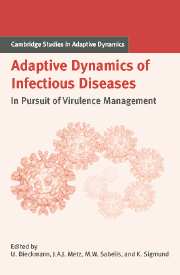Book contents
- Frontmatter
- Contents
- Contributing Authors
- List of Boxes
- Notational Standards
- 1 Introduction
- A Setting the Stage
- B Host Population Structure
- C Within-Host Interactions
- D Pathogen–Host Coevolution
- E Multilevel Selection
- F Vaccines and Drugs
- G Perspectives for Virulence Management
- Introduction to Part G
- 27 Taking Stock: Relating Theory to Experiment
- 28 Virulence Management in Humans
- 29 Virulence Management in Wildlife Populations
- 30 Virulence Management in Veterinary Epidemiology
- 31 Virulence Management in Plant–Pathogen Interactions
- 32 Virulence Management in Biocontrol Agents
- 33 Epilogue
- References
- Index
- International Institute for Applied Systems Analysis
33 - Epilogue
Published online by Cambridge University Press: 15 January 2010
- Frontmatter
- Contents
- Contributing Authors
- List of Boxes
- Notational Standards
- 1 Introduction
- A Setting the Stage
- B Host Population Structure
- C Within-Host Interactions
- D Pathogen–Host Coevolution
- E Multilevel Selection
- F Vaccines and Drugs
- G Perspectives for Virulence Management
- Introduction to Part G
- 27 Taking Stock: Relating Theory to Experiment
- 28 Virulence Management in Humans
- 29 Virulence Management in Wildlife Populations
- 30 Virulence Management in Veterinary Epidemiology
- 31 Virulence Management in Plant–Pathogen Interactions
- 32 Virulence Management in Biocontrol Agents
- 33 Epilogue
- References
- Index
- International Institute for Applied Systems Analysis
Summary
Far from conquering infectious diseases through good sanitation, vaccines, and antimicrobial agents, populations of humans – as well as those of other animals and plants – continue to be harassed by an onslaught of pathogens. Complex processes of host–pathogen adaptation are responsible for the perennial persistence of this threat.
To develop sustainable control strategies, it is important to ask which new selective pressures on virulence will thus be created, and how resistance against control measures can be slowed, prevented, or even reversed. On the one hand, population growth, increased mobility, and climate change create new opportunities for diseases, while on the other hand adaptations allow disease agents to overcome the current transmission barriers.
Can epidemiological changes be steered in the desired directions and can they be prevented from veering off course in detrimental ways? That is what this book is about. Its aims are
To show how evolutionary epidemiology as a science can profit from modeling techniques that take both population dynamics and natural selection into account;
To explore the design of strategies for virulence management based on models of the evolutionary dynamics of pathogen–host systems;
To highlight important unresolved research questions that need to be addressed before evolutionary predictions and management options are to be trusted; and
To foster the dialogue between theorists and empiricists in the field of evolutionary epidemiology.
What are the general predictions regarding the evolution of virulence traits, as they have emerged throughout this book?
- Type
- Chapter
- Information
- Adaptive Dynamics of Infectious DiseasesIn Pursuit of Virulence Management, pp. 460 - 464Publisher: Cambridge University PressPrint publication year: 2002



